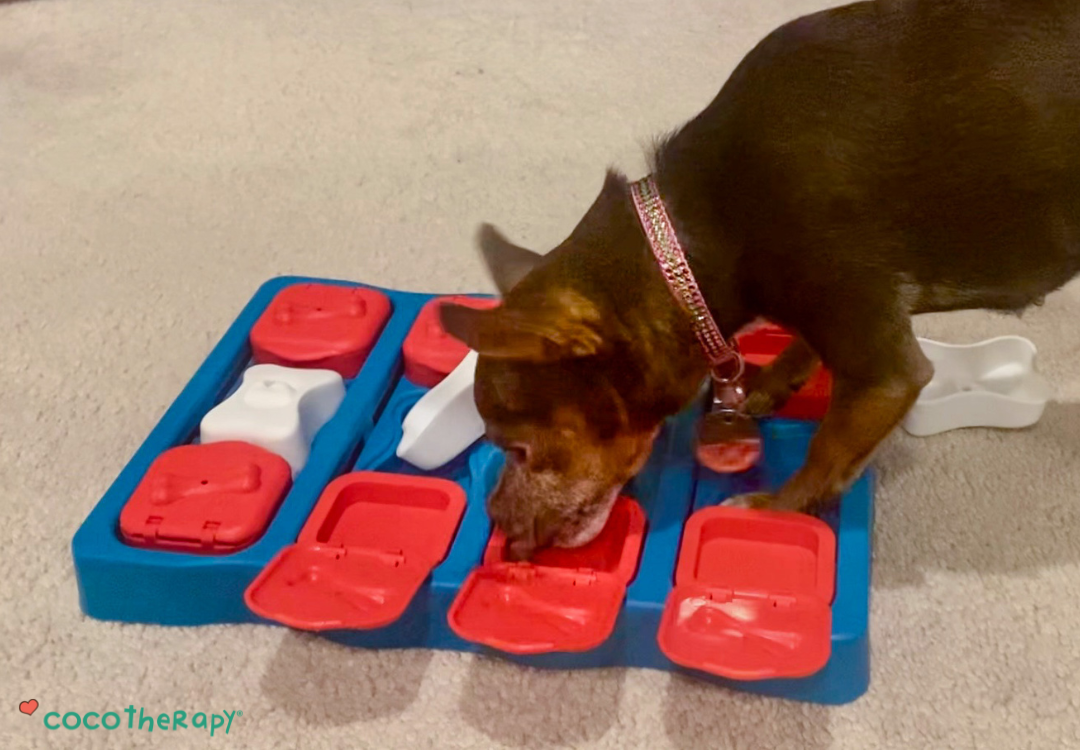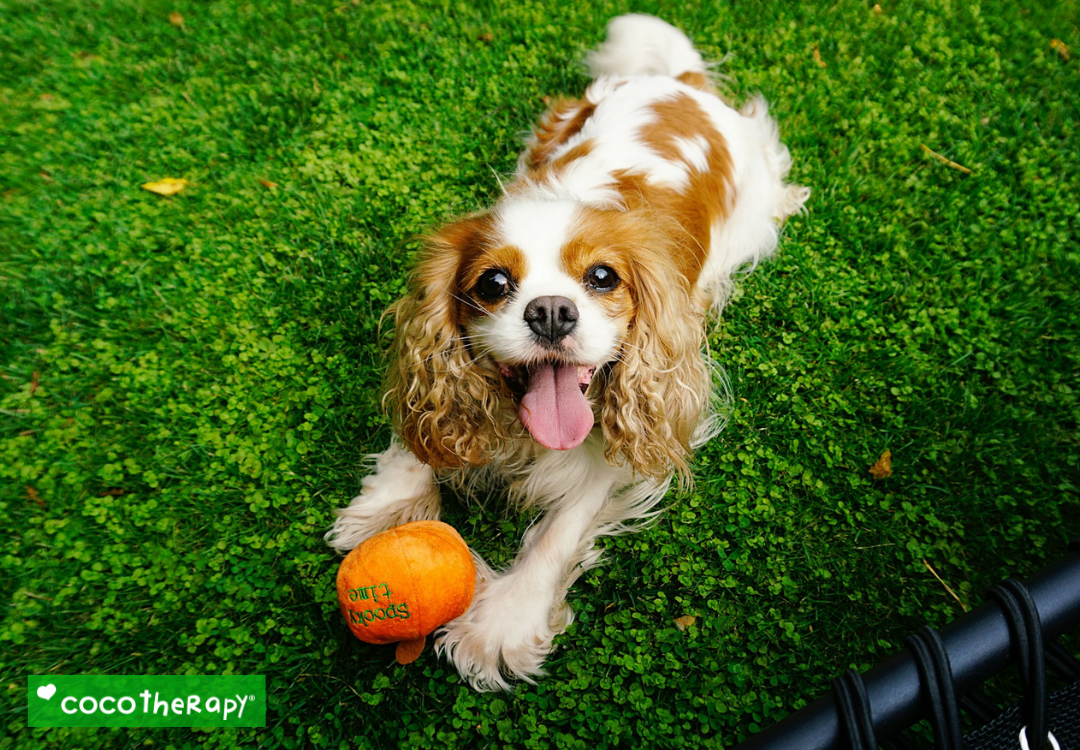Our pets are living longer than ever, which is wonderful news. But just like us, their brains and nervous systems can start to slow down with age.
Between 14 and 35% of dogs over eight years old show signs of cognitive decline, and that number can reach nearly 70% by age 15 or 16. Those numbers might sound high, but they simply show how common brain aging is – and how much opportunity we have to support our pets as they grow older.
Maybe your dog seems a little lost in the hallway, or your cat has started waking you up at 3 a.m. for no reason. These small moments can make any pet parent worry, but the good news is that noticing changes early gives you the chance to help your furry friend stay sharp, comfortable, and happy for years to come.
At CocoTherapy, we believe natural, proactive care makes all the difference. In this guide, we’ll walk you through the early signs of neurological decline, what to track, and how to support your pet’s brain health with balanced nutrition, enrichment, and gentle daily routines.
Understanding Neurological Decline in Pets
Neurological decline simply means your pet’s brain or nervous system isn’t working quite as smoothly as it used to.
It can happen gradually with age or be linked to conditions like cognitive dysfunction (similar to dementia in humans), stroke, seizure disorders, brain inflammation, or even tumors. Some changes are harmless quirks, while others are early warning signs that need attention.
If your pet seems slower to respond, hesitates on the stairs, or loses interest in play, it doesn’t always mean something serious. Sometimes the brain just needs a little extra support. Think of it like giving your senior pet a mental tune-up. When you notice changes early, you can adjust their care and help them stay confident and engaged.

Early Signs You Shouldn’t Ignore
Most neurological changes start subtly. You might chalk them up to “just getting older,” but keeping an eye on the small stuff helps you act sooner rather than later. Here are a few signs to watch out for:
- Disorientation or confusion. Your pet may wander aimlessly or get “stuck” behind furniture like they’ve forgotten the way out.
- Changes in sleep. Staying up all night and napping all day can mean the brain’s sleep cycle is off.
- Head pressing or circling. These behaviors can signal irritation or pressure in the brain and deserve quick attention.
- Wobbly movement. Tripping on flat floors or hesitating on steps may indicate nerve or spinal issues.
- House training problems. Accidents indoors could be a sign of cognitive decline, not bad manners.
- Personality changes. An affectionate pet might become clingy, anxious, or withdrawn.
- Restlessness or vocalizing. If your pet paces or cries for no clear reason, something might be off neurologically.
If more than one of these sounds familiar, jot them down and bring the notes to your vet. And don’t panic – sometimes simple changes in diet, supplements, or routine can help more than you’d think.
What to Track and How to Share It with Your Vet
You don’t need to be a scientist to track useful info. A notebook or notes app works just fine. Write down when the behavior happens, what’s happening around it, and how long it lasts. For example: Monday – pacing before dinner for two minutes. These details can help your vet spot patterns quickly.
If you have more than one pet, note how they interact. A senior pet that seems nervous around a younger, playful dog might be feeling overwhelmed or unsteady. Short, calm one-on-one time can help.
Videos are helpful too. For example, if your dog starts limping or favoring one leg, record it. Your vet will appreciate seeing the issue in motion, rather than just hearing about it second-hand.
When It’s Time to Call Your Vet
Even if symptoms seem mild, it’s always worth checking in early. Some neurological issues progress quickly, while others can be managed with the right plan. Bring your notes and ask questions like:
- Do you think these behaviors could be normal aging, or something more serious?
- What kinds of tests could help us figure out what’s going on?
- Would diet changes or something like MCT oil make a difference?
- What can I do at home to keep them safe and comfortable?
While you’re there, ask your vet to run a quick senior wellness panel: basic bloodwork, a urine test, and a brief neurological check, so any hidden issues get caught early and your pet stays happy and comfortable.
Your vet can help identify any underlying medical issues and offer practical advice for making simple, effective changes at home.
In the meantime, make life easier for your pet. Add non-slip mats, set up night lights, and keep furniture in familiar spots. Little things like that can make a big difference for balance and confidence.
Natural Ways to Support Brain and Nerve Health
If your pet’s showing early signs of cognitive decline, don’t lose hope. There’s a lot you can do to keep their brain happy and active.
At CocoTherapy, we focus on three pillars: good nutrition, mental stimulation, and a calm, predictable routine. Here's a quick overview of how you can incorporate these pillars into your pet's lifestyle to support their brain and nerve health:
Nutrition That Feeds the Brain
Food plays a huge role in brain health. Nutrients like omega-3 fatty acids, antioxidants, and healthy fats support memory and focus. Think of them as fuel for your pet’s neurons.
Add foods like sardines, salmon, blueberries, or spinach for natural brain support. Avoid overly processed foods that cause energy spikes and crashes. And if your pet’s appetite changes with age, consider smaller, more frequent meals to keep their energy stable.
The Power of MCT Oil
One of the best tools for cognitive support is MCT oil. MCTs (medium-chain triglycerides) are special fats that the body quickly converts into ketones, which give the brain an extra source of energy.
Studies show that adding MCT oil to a senior dog’s diet can sharpen mental focus and boost alertness. One double-blinded clinical trial on dogs with cognitive dysfunction reported significant improvements after 90 days on an MCT-rich diet (Pan 2018).
An earlier study found lasting cognitive gains when senior dogs were fed medium-chain triglycerides for eight months (Pan 2010). A 2024 follow-up study also confirmed that MCT supplementation supports healthy brain metabolism and wider metabolic benefits in aging dogs (Pan 2024).
Our CocoTherapy TriPlex MCT-3 Oil was designed especially for pets. It’s made from 100% pure, organic, non-GMO coconut oil and contains three key fatty acids – caprylic (C8), capric (C10), and lauric acid (C12). This trio works together to provide both quick and long-lasting brain energy. While C8 and C10 give an immediate mental boost, C12 helps sustain it over time, keeping your pet’s mind steady between meals.
TriPlex MCT-3 Oil also supports the immune system and digestion, so you’re nourishing your pet inside and out. Start with a tiny amount mixed into meals (a holistic vet can help with dosage). Most pets love the mild coconut flavor, so you won't have much trouble getting them to eat it!
Curious about how MCT oil benefits pets with neurological issues? Check out our previous post, Can MCT Oil Help Manage Seizures in Pets for more science-backed insights.
Enrichment and Daily Routine
Keeping your pet’s brain busy is one of the best ways to slow cognitive decline. And the fun part? You can do it through play and simple daily activities. Here are a few easy ideas you can try at home:
- Rotate favorite toys weekly. Giving toys a break can make them feel exciting and new when you bring them back into rotation, keeping your pet engaged.
- Hide treats for sniffing games. Create a fun scavenger hunt by hiding treats around your home or yard, encouraging your pet to use their nose and problem-solving skills.
- Teach easy new tricks. Simple tricks like “touch” or “spin” not only keep your pet entertained but also help build their focus, confidence, and coordination.
- Go on slow “sniffari” walks. Let your pet guide the walk, taking time to explore different scents and surroundings. It’s a great way to give them mental stimulation and a sense of adventure.
A calm, predictable routine is just as important. Feed meals around the same time each day, keep lighting consistent in the evening, and create a quiet space where your pet can rest. Seniors especially appreciate a little structure. It keeps them grounded and less anxious.
If your pet struggles with balance, place rugs on slippery floors and use ramps instead of stairs when possible. When your pet feels comfortable, they feel more confident. And a confident pet is a happy pet.
How Can You Help Your Pet Stay Happy and Sharp?
The best time to start supporting your pet’s brain health is now – no matter their age. Even small changes made early can have a lasting impact on how they think, move, and feel. Caring for an aging pet isn’t about turning back the clock. It’s about helping them stay confident, connected, and full of joy as they grow older.
At CocoTherapy, we believe early action is simple and powerful. Keep an eye on small changes in your pet’s behavior, talk with your vet, and make a few easy adjustments to their daily routine. Nourish their brain with wholesome foods, provide plenty of mental stimulation, and consider adding CocoTherapy TriPlex MCT-3 Oil to their diet for extra cognitive support.
Most importantly, enjoy the little things like the silly habits, the slow strolls, and the quiet moments curled up together. Your pet’s health and happiness are connected. With love and care, you can keep them happy and active for years to come.
Curious how MCTs support your pet’s brain and overall wellness? Download our free eBook to explore scientific studies showing how MCTs in coconut oil promote brain health.



